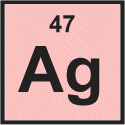|
|
- Symbol: Ag
- Atomic Number: 47
- Atomic Weight: 107.8682
- Classification: Transition Metal
- Phase at Room Temperature: Solid
- Density: 10.49 grams per cm cubed
- Melting Point: 961°C, 1763°F
- Boiling Point: 2162°C, 3924°F
- Discovered by: Known about since ancient times
|
